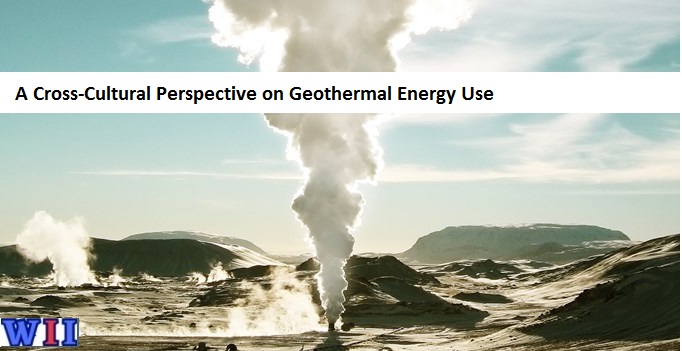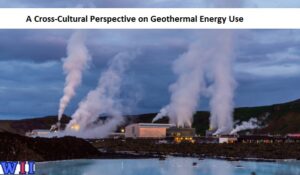Global Geothermal Energy: In the burgeoning world of renewable energy, where the dazzling power of solar and the blustering might of wind are often in the limelight, geothermal energy is the unsung hero. This seemingly understated power source, simmering beneath the surface of the Earth, possesses the formidable potential for steady and continuous power generation. Given the increasing global energy demands, it is imperative to gain an understanding of global geothermal energy trends, not as an isolated study, but from a cross-cultural perspective. This approach offers an insight into a kaleidoscope of practices and attitudes towards this natural resource, paving the way for a globally unified push towards wider acceptance and utilization of geothermal energy.
The Basics of Geothermal Energy
Geothermal energy, in its most fundamental sense, is the heat that lies deep within the Earth’s crust. This seemingly infinite energy source originates from both the original formation of the planet billions of years ago and the ongoing radioactive decay of minerals.
Tapping into this subterranean powerhouse requires a blend of technical prowess and natural conditions. This involves drilling wells into geothermal reservoirs to tap into the reservoirs of hot water and steam, which is then directed to power turbines.
Geothermal power plants are the technological marvels that make this possible. They employ three main methods: dry steam, flash steam, and binary cycle power stations. While dry and flash steam plants draw steam directly from a geothermal reservoir, binary cycle power stations work on a heat exchange principle. They transfer the heat from geothermal hot water to another liquid with a lower boiling point, thereby creating steam.
Global Geothermal Energy Production
The production of geothermal energy on a global scale is a swiftly changing panorama. Several countries have emerged as key players, including the United States, Philippines, Indonesia, and Turkey. Each boasts unique geographies and innovative strategies for the extraction and generation of geothermal energy.
However, the future also lies in the hands of emerging markets such as Kenya, Mexico, Iceland, and New Zealand. Kenya, for instance, is investing substantially in geothermal power as part of its forward-looking Vision 2030 strategy. Mexico, situated on the tectonically active Pacific Ring of Fire, seeks to capitalize on its geographical advantage. Iceland and New Zealand, steeped in geological activity, possess a rich wealth of geothermal resources waiting to be harnessed.
Geothermal Energy in Different Cultures
Geothermal energy has a long and varied cultural history, deeply ingrained in societies from New Zealand to North America. The Maori culture in New Zealand, for example, saw geothermal features as sacred sites. Native American tribes in the United States, too, recognized the therapeutic properties of hot springs.
Ancient civilizations were no strangers to the benefits of geothermal energy. The Roman and Greek civilizations built grand bathhouses around hot springs, leveraging their supposed medicinal properties. Icelandic cultures, too, have a long-standing tradition of using geothermal resources, mainly for heating homes and cooking.
Geothermal Energy and Sustainability
Geothermal energy’s potential for environmental sustainability is vast. One of its most significant advantages is the reduction in greenhouse gas emissions. Unlike fossil fuels, geothermal power plants emit only a fraction of the carbon dioxide, making it a low carbon footprint energy source.
Moreover, geothermal energy signifies the sustainable use of natural resources, turning the constant heat beneath our feet into usable power. Its viability as an alternative to fossil fuels is undeniable, with continuous power supply irrespective of weather conditions or time of day. In alignment with the United Nations Sustainable Development Goals, geothermal energy stands as a sturdy pillar in the fight against climate change and in the stride towards a sustainable future.
Challenges and Opportunities in Geothermal Energy Development
The path to unlocking geothermal energy’s full potential is strewn with challenges. These span technical aspects, such as locating geothermal resources and ensuring their sustainable extraction, to economic hurdles involving financial feasibility and the quest for innovative financing options.
Furthermore, the policy and regulatory frameworks that guide geothermal energy development vary significantly across nations, as do the efforts towards research and development in geothermal technology. However, these challenges should be seen as opportunities. They serve as catalysts for innovation, collaboration, and an international drive towards the broader application of geothermal energy.
Cross-Cultural Perspectives on Geothermal Energy Utilization
The adoption of geothermal energy is influenced by a tapestry of cultural barriers and opportunities. Indigenous knowledge and practices often offer ingenious ways of harnessing geothermal resources. These diverse perspectives underscore the importance of collaboration and knowledge exchange among geothermal-rich countries, fostering a sense of global unity in the march towards renewable energy.
Innovative Geothermal Applications
The breadth of geothermal energy applications extends far beyond mere electricity generation. Geothermal heating and cooling systems, for instance, present a sustainable solution for temperature management in buildings. Geothermal energy’s direct use in agriculture and aquaculture aids in maintaining optimal conditions for crop and fish growth, respectively.
Furthermore, geothermal energy spurs tourism development around hot springs and geysers, contributing to local economies. Certain industrial processes can also utilize geothermal energy, further diversifying its applications and illustrating its versatility.
Geothermal Energy and the Future
Geothermal energy stands at the cusp of significant growth in the global energy mix. Technological advancements are expected to further streamline its extraction and usage. The need for reliable, clean energy sources is on an upward trajectory, amplifying the importance of forecasting global geothermal energy trends. This endeavor, though complex, is vital to shaping a sustainable and equitable energy future.
Conclusion of A Cross-Cultural Perspective on Geothermal Energy Use
From the deep recesses of the Earth to the grand stage of global sustainable energy, geothermal energy has traversed a remarkable journey. It has intertwined itself into the fabric of diverse cultures, serving as a testament to its universal appeal and importance. Embracing geothermal energy from this cross-cultural perspective is not merely an intellectual exercise; it is a call to action. Governments, industries, and individuals must rally behind geothermal energy development, recognizing it as a key player in our march towards a sustainable future.
FAQs
Q1 How does a geothermal power plant work?
Ans: A geothermal power plant works by tapping into the heat deep beneath the Earth’s surface, using it to create steam that drives turbines and generates electricity.
Q2 What makes geothermal energy a sustainable option?
Ans: Geothermal energy is considered sustainable because it leverages the Earth’s natural heat, produces minimal emissions, and has a low carbon footprint compared to fossil fuels.
Q3 How does geothermal energy usage vary across cultures?
Ans: Geothermal energy usage varies across cultures, from heating and cooking in Iceland to sacred bathing rituals in Ancient Roman and Greek civilizations.
Q5 What challenges are associated with geothermal energy development?
Ans: Geothermal energy development faces several challenges, including the technical difficulties of accessing geothermal resources, financial feasibility, and the need for supportive regulatory frameworks.
Q6 What are some innovative applications of geothermal energy?
Ans: Innovative applications of geothermal energy include geothermal heating and cooling systems, direct use in agriculture and aquaculture, tourism development, and use in various industrial processes.
Also read: The Future of Geothermal Energy: Predicted Market Trends
Our Reader’s Queries
What percentage of global energy is geothermal?
Despite its potential, geothermal energy only makes up 0.5% of renewable energy sources used for electricity generation, heating, and cooling worldwide.
Who is the largest global producer of geothermal energy?
In 2021, the geothermal power market is being spearheaded by the United States of America, with Indonesia, the Philippines, Turkey, and New Zealand following closely behind. These five countries are the top performers in geothermal power generation, showcasing their commitment to sustainable energy sources.
How big is the global geothermal energy market?
The Geothermal Energy market is on the rise, with a current value of USD 5733.42 million in 2022. This renewable and clean power source is derived from the thermal energy in subterranean earth. Experts predict that the market will continue to grow at a CAGR of 6.16% during the forecast period, reaching a value of USD 8209.21 million by 2028.
Is geothermal energy available worldwide?
Geothermal energy is a popular source of electricity in 26 countries and heating in 70 countries.



